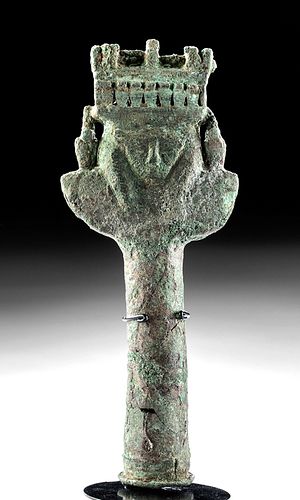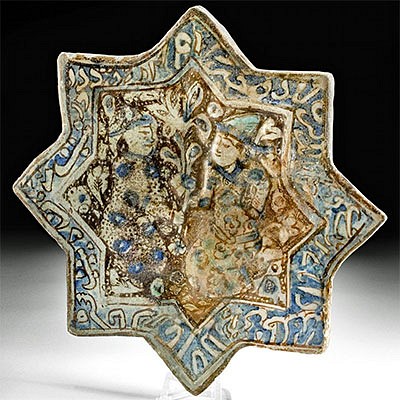Romano-Egyptian Bronze Sistrum Handle Double Hathor
Lot 21
About Seller
Artemis Fine Arts
686 S Taylor Ave, Ste 106
Louisville, CO 80027
United States
Selling antiquities, ancient and ethnographic art online since 1993, Artemis Gallery specializes in Classical Antiquities (Egyptian, Greek, Roman, Near Eastern), Asian, Pre-Columbian, African / Tribal / Oceanographic art. Our extensive inventory includes pottery, stone, metal, wood, glass and textil...Read more
Estimate:
$3,100 - $4,650
Absentee vs Live bid
Two ways to bid:
- Leave a max absentee bid and the platform will bid on your behalf up to your maximum bid during the live auction.
- Bid live during the auction and your bids will be submitted real-time to the auctioneer.
Bid Increments
| Price | Bid Increment |
|---|---|
| $0 | $25 |
| $300 | $50 |
| $1,000 | $100 |
| $2,000 | $250 |
| $5,000 | $500 |
| $10,000 | $1,000 |
| $20,000 | $2,500 |
| $50,000 | $5,000 |
| $100,000 | $10,000 |
| $200,000 | $20,000 |
About Auction
By Artemis Fine Arts
May 20, 2021
Set Reminder
2021-05-20 10:00:00
2021-05-20 10:00:00
America/New_York
Bidsquare
Bidsquare : Ancient & Ethnographic From Around The World
https://www.bidsquare.com/auctions/artemis-gallery/ancient-ethnographic-from-around-the-world-6979
Ancient art from Egypt, Greece, Italy and the Near East, as well as Asian, Fossils, Pre-Columbian, Native American, African / Tribal / Oceanic, Fine art, and much more! All categories, all price ranges... all legally acquired and guaranteed to be as described or your money back. Artemis Fine Arts info@artemisgallery.com
Ancient art from Egypt, Greece, Italy and the Near East, as well as Asian, Fossils, Pre-Columbian, Native American, African / Tribal / Oceanic, Fine art, and much more! All categories, all price ranges... all legally acquired and guaranteed to be as described or your money back. Artemis Fine Arts info@artemisgallery.com
- Lot Description
Egypt, Romano-Egyptian period, ca. 30 BCE to 2nd century CE. A lovely example of a bronze sistrum handle with rich decoration, featuring a long cylindrical column for gripping that rises to meet a double Hathor head complete with a relief face and elaborate wig. Perched atop her head is the ornate support for the rest of the instrument, which would have once towered above her. Hathor, associated with the goddess Isis in the Romano-Egyptian period, was considered the primeval goddess from which all others derived. Size: 2.1" W x 5.25" H (5.3 cm x 13.3 cm); 5.3" H (13.5 cm) on included custom stand.
The sistrum, meaning "that which is being shaken" in Greek, is a percussive musical instrument, known mostly from ancient Egypt and Mesopotamia. When shaken, the metal rods within the arch produce a sound that can range from a soft clank to a loud jangling. Some people even hear a sound complementary to that of a hissing snake when the sistrum is played. The sistrum was particularly important for the Egyptian worship of the goddesses Hathor and Bastet. You can imagine priestesses playing these, singing, while processing into a temple built to worship these powerful goddesses.
Provenance: private collection, Beaverton, Oregon, USA, acquired between 2007 to 2009; ex-Tom Cederlind collection, Nunismatics & Antiquities, Portland, Oregon, USA, before 2009
All items legal to buy/sell under U.S. Statute covering cultural patrimony Code 2600, CHAPTER 14, and are guaranteed to be as described or your money back.
A Certificate of Authenticity will accompany all winning bids.
We ship worldwide and handle all shipping in-house for your convenience.
#151252Handle is repaired from multiple pieces, mainly near the bottom of the piece, and has some small losses along the repair lines. Upper part of the instrument is lost. Nice patina and deposits on surface, with form well preserved.Condition
- Shipping Info
-
All shipping is handled in-house for your convenience. Your invoice from Artemis Gallery will include shipping calculation instructions. If in doubt, please inquire BEFORE bidding for estimated shipping costs for individual items.
-
- Buyer's Premium



 EUR
EUR CAD
CAD AUD
AUD GBP
GBP MXN
MXN HKD
HKD CNY
CNY MYR
MYR SEK
SEK SGD
SGD CHF
CHF THB
THB














